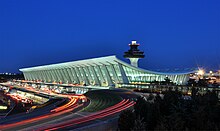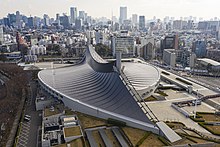Suspended structure

A suspended structure is a structure which is supported by cables coming from beams or trusses which sit atop a concrete center column or core. The design allows the walls, roof and cantilevered floors to be supported entirely by cables and a center column.
Another type of suspended structure, suspended catenary, uses outer-wall concrete columns angled away from the center with a cable system strung between them suspending a roof and outer wall structure. In this example there are no supports or visual obstructions inside the structure.
Background
Some of the first suspension structures were bridges. The first iron chain suspension bridge in the Western world was the Jacob's Creek Bridge (1801) in Westmoreland County, Pennsylvania, designed by inventor James Finley.[1] The Golden Gate Bridge in San Francisco, California, is another example of a suspension structure. Much like the suspended building structure, towers hold the weight and cables support the bridge deck. In the case of suspension bridges, there is "tensional force" transferred to the columns.[2]
Design
Minimal interior visual obstruction is a feature of all suspended structure buildings. The architectural method creates a visually striking open space in the interior of the structure. The load for the suspended structure is either a suspended catenary or is supported by truss-work carrying the weight of the building through a building core. [3]
Engineering
Suspended structures of the center column type utilize high-strength cable to suspend or support the floors. In some cases beams are cantilevered out from the concrete column at the center of the building. From the top of the center column, cables are used to support the roof system and the walls. Cables run down from the top of the tower to support floors. The external skeleton of the structure is a type of curtain wall which also is supported by cables.[4] Suspended structures often allow much light to enter, because of the unobstructed interior.[5]

An example of a catenary-shaped suspended structure is the Eero Saarinen designed Dulles International Airport. The roof of the structure is made up of suspension cable which stretches across angled concrete columns. In the design of Dulles airport, the floor, the columns and the roof all work together to allow the walls and ceiling to float.[6] This leaves a large open space for the building.[7]
The Yoyogi National Gymnasium in Tokyo is an example of a cable suspended structure. The roof system is a large span and the structure has been called "one of the most beautiful buildings in the 20th century", largely due to the suspended roof system.[8]
Examples of suspended structure buildings
- BP Building (Antwerp) (1963)[9]
- HSBC Building (Hong Kong) (1985)[10]
- Central Plaza (Dublin)
- Riverplace Tower (1966)[11]
- Yoyogi National Gymnasium (1964)[8]
- State Theatre (Hong Kong) (1952)
- Atrium Link (1997) and Atrium Link Extension (2009), Convention and Exhibition Centre, Hong Kong
See also
Gallery
-
BP Building roof truss suspended structure
-
HSBC Building (Hong Kong) steel suspended structure
-
Riverplace Tower, Jacksonville, Florida: structural support from the central core and the external vertical beams.
-
Central Plaza (Dublin) external support detail
References
- ^ "Iron Wire of the Wheeling Suspension Bridge". Smithsonian Museum Conservation Institute. Archived from the original on 30 April 2011.
- ^ Lamb, Robert; Morrissey, Michael; Kiger, Patrick J. (12 November 2021). "How Bridges Work". Science How Stuff Works. Archived from the original on 15 January 2022. Retrieved 15 January 2022.
- ^ Kohn, A. Eugene (2002). Building type basics for office buildings. New York: J. Wiley & Sons. p. 86. ISBN 0-471-38923-4. Archived from the original on 26 February 2022. Retrieved 15 January 2022.
- ^ "Design of two buildings with suspended structures". Barrett Byrd Associates. 3 January 2018. Archived from the original on 14 March 2021. Retrieved 15 January 2022.
- ^ Harris, James B. (1996). Masted structures in architecture. Oxford: Butterworth Architecture. p. 6. ISBN 0-7506-1282-7. Archived from the original on 26 February 2022. Retrieved 15 January 2022.
- ^ Saarinen, Eero. "Dulles International Airport, Virginia" (PDF). eng umd. Archived (PDF) from the original on 15 January 2022. Retrieved 15 January 2022.
- ^ Lewis, Roger K. (26 March 1994). "Dulles Needs to Spread its Wings". The Washington Post. Retrieved 15 January 2022.
- ^ a b Chen, Airong; Ruan, Xin; Frangopol, Dan M. (2020). Life-cycle civil engineering : innovation, theory and practice : proceedings of the 7th International Symposium on Life-Cycle Civil Engineering (IALCCE 2020), October 27-30, 2020, Shanghai, China. Boca Raton: CRC Press. p. 42. ISBN 978-0367360191. Retrieved 15 January 2022.
- ^ "BP-building". inventaris onroerenderfgoed. Onroerenderfgoed. 29 March 2019. Archived from the original on 14 January 2022. Retrieved 14 January 2022.
- ^ "HSBC Building by Norman Foster: Missing internal support structure". Thinking Future. Rethinking Internet Media. 12 May 2021. Archived from the original on 15 January 2022. Retrieved 15 January 2022.
- ^ "Riverplace Tower". Riverplace Tower. Gate Riverplace Company. Archived from the original on 16 January 2022. Retrieved 15 January 2022.
External links
- Buildings with suspended structures in seismic areas
- Earthquake resistance of buildings with suspended structures
Further reading
- Rose, G M (1964). Proceedings of the Institution of Civil Engineers Suspended Buildings Volume 28 Issue 2. Scotland: ICE Publishing.
- Nageim, Hassan Al; MacGinley, T.J. (1981). Steel Structures: Practical Design Studies, Third Edition. New York: Taylor & Francis. ISBN 0-415-30156-4.



